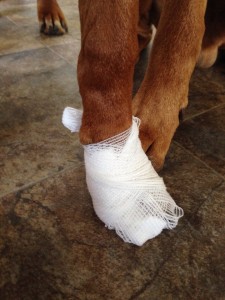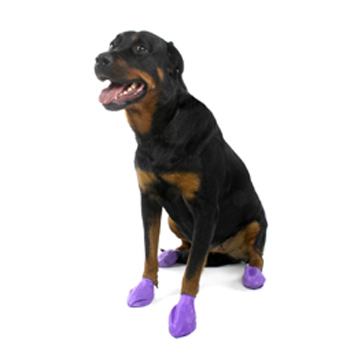Cut Paw Pad: It’s not always obvious when a dog cut’s his paw and often it might not be unless you actually see him limping or spot blood on the ground. Often it’s not until he comes home or you give his muddy paws a rub over that you notice the problem. The important thing is to start your treatment of it as soon as you do actually notice.
When dealing with a bleed, we always go through the SEEP checklist as follows:-
Firstly, if you are in any doubt as to whether you may get bitten as you try to help your dog, muzzle him first or take him directly to the vet. We certainly don’t want another injury!
S = Sit or Lie the dog down so that the wounded limb is raised. In the case of an injured paw, the dog will need to lie down so that he can take the weight off the limb and you can raise it for him.
E = Eleveate the injured limb above the level of the heart to slow down the blood loss
E = Examine the paw thoroughly. The cut may be a simple surface wound or it may be a deeper slice. There may be debris or even a thorn or piece of glass still left in the wound.
P = Pressure is necessary if the paw is bleeding. If it is not, then do not apply pressure to the wounded limb.
Treatment
Next, if possible, bathe the foot in warm Epsom salts for ten minutes, swilling the water across the wound as you go in an effort to remove any remaining smaller bits of debris.
Once you have soothed the pad in the warm water and you are confident you have removed any bits of dirt or grit, dry the foot completely. It is advisable not to use a fabric cloth or towel to dry the limb as this may leave fibres in the wound – always use a paper towel and try not to press on the wound itself. The bathing routine should be repeated twice a day until the wound has healed.
If you have any an antibiotic, such as Neosporin with pain relief, or failing that antibacterial cream or manuka honey, this can be gently dabbed onto the wound itself. Each time you bathe the pad, be sure to dry it completely and reapply the ointment.
If the wound is deep or severe, you will need to protect the wound further by wrapping it in gauze to prevent further contamination. It is important to make sure that you do not wrap the gauze or dressing too tightly. There should be no flesh bulging at the top of the dressing and the limb should not feel too “firm” when you gently squeeze it. If there is no “give” in your hand, you have done it too tightly and may be cutting off the blood supply to the paw.

Remember to try to keep your dog from paying too much interest to the injury. If you are unable to to stop him licking and worrying the wound, it might be necessary to use a Buster/Elizabethan collar.
It is important to keep a close eye on just how well the pad is healing and as you will be bathing and treating the wound twice a day, you may need to take a picture of it so you can be sure if there has been improvement or not (often if we look at things too regularly it’s difficult to tell if there have been changes).
If you think the wound is not healing, is worsening, is causing the dog to limp or be in more pain, or is showing any signs of heat or infection, do not delay in seeking a professional opinion from the vet. It might be that a foreign body has been missed and is still in the wound and, if left, this could cause further and more serious problems.


